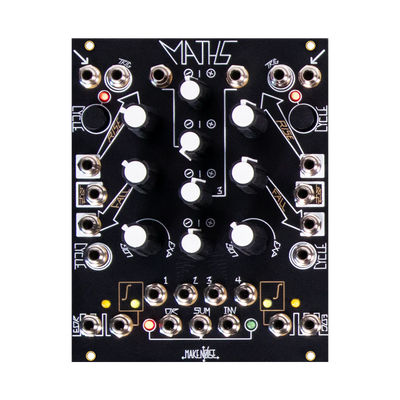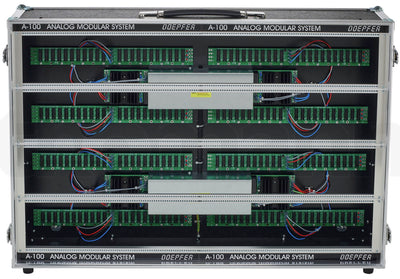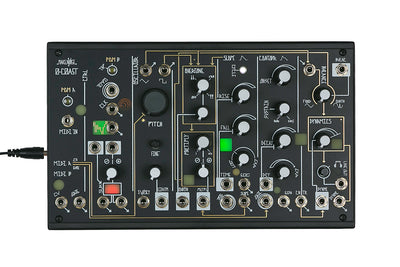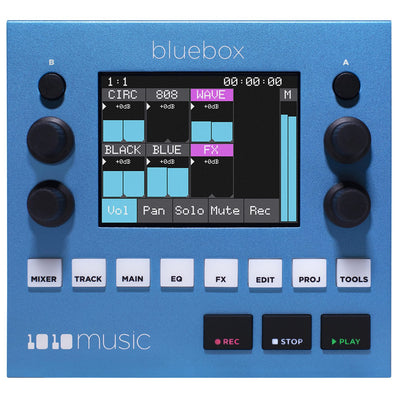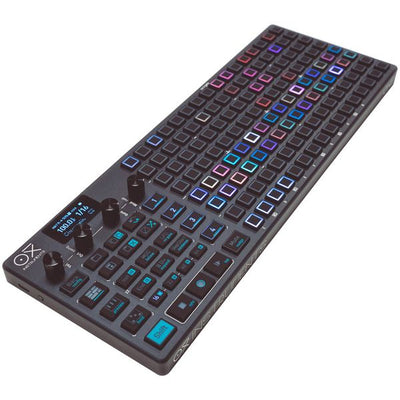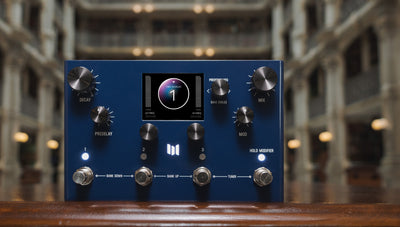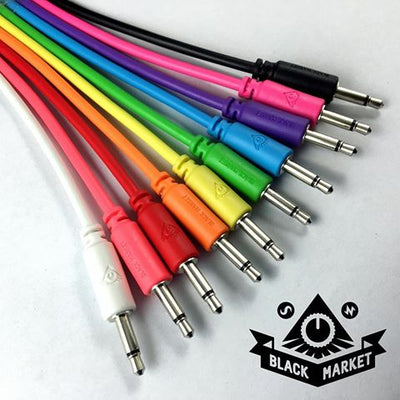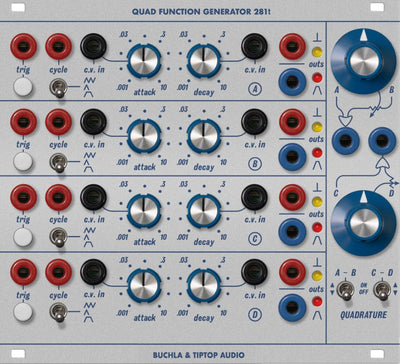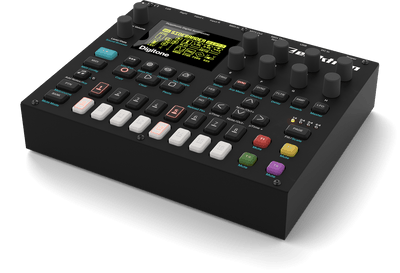The Synthesis Technology E370 is a 4-channel DSP-based VCO, 54HP wide module that incorporates features from the E340 Cloud Generator and the E350 Morphing Terrarium (both are discontinued), while adding additional modes from the E352 Cloud Terrarium. It uses 105ma of +12V and 32ma of -12V.
VCO Architecture
Each VCO is independent in the E370, but the 'pooled CV buss' (see description below) allows sharing of CV and mixing of audio outputs if desired.
The VCO is based upon a unique implementation of wavetable synthesisusing 256 fixed-sample-length tables of 16-bit values. Each bank in memory consists of 64 wavetables, in an 8x8 array (like a chessboard). Our proprietary DSP algorithms then allow either smooth or 'glitched' morphing between the wavetables in various ways. The E370 comes with 3 factory banks (192 total waves) and internal FLASH memory to hold 26 user-defined banks. This allows over 1,650 individual wavetables to be accessible. The free, cross-platform WaveEdit program is used to generate and import WAV files to user Banks.
Each VCO has 2 CV inputs with an initial value (called the 'Parameter' or PARM) and the external patched-in CV through an attenuator (the 'Mod'). The external Mod is added to the Parameter setting. Some VCO Modes have more than 2 things to 'wiggle', so you can either:
- Use a fixed value from 0-100
- Share another CV resource
Color LCD/Navigation
Everyone hates 'menu-diving', us included. That's why we focused on making the most 'shallow' menu system possible. Everything is just 1 or 2 clicks away. No endless screens and pages to remember. The encoder is a mil-spec Grayhill optical encoder with a 25yr typical life. And if it ever needs replacing, it's on a easy to access cable assembly.
The color LCD lets you customize the color scheme with 64 different colors to pick from.
There are several included 'visual aids' that can be displayed on the LCD:
- Each of the 4 VCO's waves/noise modes, updated 20FPS
- Lissajous figures, where the X/Y axis are user selectable
- Real-time FFT spectra of the audio output when in the 2-op FM mode
- Graphical maps of the X and Y PARM CVs
Sharing CV Resources
The factory default state of the E370 is each VCO has 2 PARMs called X and Y. VCO1 has X1 and Y1, VCO2 has X2 and Y2, and so on. However, these are not 'hard' assignments, just the default ones. You can share ANY of the 8 PARMs across 1-4 VCOs. For example, PARM Y3 can be assigned to all 4 VCOs at once, so turning the PARM Y3 knob and the external MOD Y3 CV is fed to every VCO. This voltage can then modulate each VCO in a different way, depending on where you assign it.
User Wavetables and Patch Storage
You can load your own sets of wavetables using the uSD card interface. The uSD card is NOT REQUIRED to run the E370. It is also used for firmware updates. The free application WaveEdit is used to format the wave data and bank data into the proper format used inside the E370.
The E370 has internal non-volatile memory for storing both User wavetables/Banks and for Patches. A 'Patch' stores the menu settings for all 4 VCOs. There are 16 Patches available, and a Patch can be quickly recalled for live performances.
Audio Output Mixer
The default state of the Mixer is each VCO is full volume and only appears at its own output jack. Using the Mixer screen, each VCO output can be mixed with all the others. This is useful for the Morph + Phase mode, and also during live performance where only 2 audio outs are commonly used. The mixing levels are fixed in log steps: there is no 'CV-controlled mixing' function.
VCO Modes
Although the E370 excels at smooth morphing between wavetables (first introduced in the E350 Morphing Terrarium in 2010), traditional VCO waves such as saws, pure sines, and filtered noise (using a 4-pole resonant lowpass ladder filter) can be selected. Thru-zero, linear FM (in 3 ranges) can be used on not just triangle waves (as in an analog VCO) but with ANY waveshape or any wavetable. Here are all the different modes you can place each VCO in, and remember each VCO can be a different mode.
- Morphing - Use 2 CVs to select where in the 8x8 bank of wavetables the output is generated. This is the E350's mode.
- Morph + Phase Shifting - used when mixing with another VCO (or driving laser galvos). Audio-rate modulation generates classic PM tones. Wavetable morphing plus a voltage-controlled phase shifter.
- Morph + Wavefolder - can you wavefold a wavetable? Sure you can...now.
- Cloud Generator - this is an improved E340 mode. Not just saws or sines, but can 'cloud' any wavetable, while morphing. A 'cloud' is a set of detuned copies (the 'supersaw' effect)
- 2op FM - 2 operator Yamaha FM. Not limited to just sine waves, you can use wavetables as well.
- Noise - 6 types of noise plus a resonant, Moog-style ladder filter
- Sample Player - a 'lo-fi' sample player that treats the selected Bank as 1 giant WAV sample, with separate Start and Length points under voltage control.
Other VCO Features
Each VCO has the FM CV 'decoupled' from the COARSE/FINE and 1V/Oct summing point. You can re-assign a PARM CV to a VCO's FM, which can add a detuning offset. In addition, each VCO has a selectible quantizer, linear or expo response, and assignable SYNC sources (or no sync at all).
There is a unique Chord Mode that uses a 64-entry table of frequency offsets for each VCO. There are 4 preset factory Chord tables, and using a simple text file, you can create your own Chord tables (4 user slots) and load them using the uSD card. The 'notes' in the table are addressed using fixed SYNC inputs:
- SYNC1 steps forward 1 entry
- SYNC2 steps backwards 1 entry
- SYNC3 resets to the first enry
This can be thought of as a 4-channel, 64-step sequencer. The table entries are fractional semitone offsets to the COARSE/FINE panel settings. Since fractional entries are supported (like 1.64 semitones), micro-tuning chords and sequences can be generated. You can select to Loop the table or stop at the ends. You can step through the table at audio rates.
SPECS
- Module width: 54HP
- Depth behind panel (with power cable attached): 1.65in (41.9mm)
- Power: +12V @105ma, -12V @32ma
- CV In range: -5V to +5V, 12KHz
- SYNC threshold: +0.65V nominal, positive-edge slope triggers
- Wavetable format: 256 samples, 16-bit unsigned integer, .WAV
- Audio output level: 10V pk-pk
- Audio sample rate: 96KHz, 32-bit DSP engine, 16-bit output



